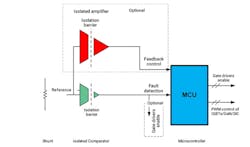Reinforced, Isolated Window Comparator Features Adjustable Threshold
Comparators are one of the basic building blocks of analog and mixed-signal designs, providing one small but critical function, as their name indicates. Their role is often to be a “simple” safety threshold switch and fault-alert source—“simple” only in the sense that they do so reliably with a minimum of support components (or any software that could crash).
Now, they’re increasingly expected to function in electrically noisy and environmentally difficult higher-voltage situations, where galvanic (ohmic) isolation is needed both for basic system performance as well as user safety.
Adding such isolation to the comparator itself is difficult. It requires more than just the basic electrical performance, but also must be designed, built, and tested to meet multiple stringent industry and government standards for voltage, ruggedness, and temperature performance.
Specs and Apps
To address this need, Texas Instruments developed the AMC23C12, a reinforced, isolated window comparator with a fast response time and open-drain output that the company maintains is an industry first (Fig. 1). Its input and output are separated by an isolation barrier certified to provide reinforced galvanic isolation of up to 5 kVRMS per DIN VDE V 0884-11 and UL1577, and it supports a working voltage of up to 1 kVPK. It’s also highly resistant to magnetic interference.
Applications include overcurrent or overvoltage detection in motor drives, frequency inverters, solar inverters, and high-power dc-dc converters—all areas where voltages and currents are high, as is user shock risk, and safety-related performance is assessed across multiple parameters.
The comparison window is centered around 0 V; therefore, the comparator trips if the absolute value of the input voltage exceeds the trip threshold value. This trip threshold is adjustable from 20 to 300 mV through a single external resistor, so the comparison window ranges from ±20 to ±300 mV.
When the voltage on the REF pin is above 550 mV, the negative comparator is disabled and only the positive comparator is functional. The reference voltage in this mode can be as high as 2.7 V (particularly useful for monitoring voltage supplies).
The open-drain output supports two modes: transparent mode where the output follows the input state, and latch mode where the output is cleared on the falling edge of the latch input signal. The device also features high common-mode transient immunity (CMTI) of 55 kV/µs (minimum), another important consideration in these operating environments.
Other Advantages
While it’s possible to build your own combination isolator/comparator, TI maintains the AMC23C12 provides these less-obvious benefits:
- Reduces “solution size” by 50% due to integration of a wide-input-range, low-dropout regulator; a window comparator; and a precision voltage reference.
- Enables use of smaller-size passive components, since the high worst-case trip threshold accuracy (better than 3%) reduces design margins.
- Provides ultra-fast overcurrent and overvoltage detection for greater system protection due to the short response time of under 400 ns.
- Eases reuse of the comparator across multiple designs due to use of a single external resistor to set the adjustable trip threshold.
Given the critical nature of many if its designs-ins, even users of components providing the basic functionality of a comparator benefit from comprehensive technical support. The 32-page datasheet has the expected specifications for the comparator across a wide range of operating conditions, including a page calling out the specific regulatory standards it meets and under what conditions. The datasheet also has some application examples and guides plus a section “what to do and what not to do”—a recognition of design reality.
Further support comes via the AMC23C12EVM evaluation module (Fig. 2), which costs $49. In addition, a detailed 15-page User’s Guide provides connection and configuration information, bill of materials, PCB layout, and more.
For those who need to further investigate approaches to fault detection in high-power systems, a brief TI blog “Addressing the growing needs of fault detection in high-power systems” goes through various ways to use combinations of isolated barriers, comparators, and modulators to achieve these goals, such as seen in Figure 3. It also has a table comparing the relative attributes of the different topologies with respect to latency, accuracy, size, cost, and isolation performance.
The AMC23C12 is available in an 8-pin, wide-body SOIC package (5.85 × 7.50 mm) and is specified over the extended industrial temperature range of –40 to +125°C.
About the Author

Bill Schweber
Contributing Editor
Bill Schweber is an electronics engineer who has written three textbooks on electronic communications systems, as well as hundreds of technical articles, opinion columns, and product features. In past roles, he worked as a technical website manager for multiple topic-specific sites for EE Times, as well as both the Executive Editor and Analog Editor at EDN.
At Analog Devices Inc., Bill was in marketing communications (public relations). As a result, he has been on both sides of the technical PR function, presenting company products, stories, and messages to the media and also as the recipient of these.
Prior to the MarCom role at Analog, Bill was associate editor of their respected technical journal and worked in their product marketing and applications engineering groups. Before those roles, he was at Instron Corp., doing hands-on analog- and power-circuit design and systems integration for materials-testing machine controls.
Bill has an MSEE (Univ. of Mass) and BSEE (Columbia Univ.), is a Registered Professional Engineer, and holds an Advanced Class amateur radio license. He has also planned, written, and presented online courses on a variety of engineering topics, including MOSFET basics, ADC selection, and driving LEDs.



